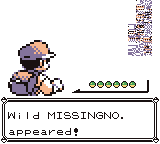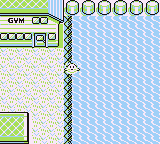
The player encountering MissingNo. in Pokémon Red.
MissingNo. (Japanese: けつばん, Hepburn: Ketsuban), also known as MISSINGNO. or MissingNO,[1] short for Missing Number,[2] is an unofficial Pokémon species found in the video games Pokémon Red and Blue. Due to the programming of certain in-game events, players can encounter MissingNo. via a glitch.
Encountering MissingNo. causes graphical errors and increases the sixth item in the player's item menu by 128; the latter effect resulted in the glitch's coverage by strategy guides and game magazines. IGN has noted MissingNo.'s appearance in Pokémon Red and Blue as one of the most famous video game glitches. Fans of the series have attempted to rationalize MissingNo. as part of the games' canon, and sociologists have studied its impact on players.[3]
History[]
Developed by Game Freak and published by Nintendo, the Pokémon series began in Japan in 1996. The player assumes the role of a Pokémon Trainer whose goal is to capture and train creatures called Pokémon. Players use the creatures' special abilities to combat other Pokémon,[4][5] and certain abilities also grant new ways to navigate the game's world, such as instantaneous travel between two areas.[6]
Nintendo of America first documented the events that cause MissingNo. to appear in the May 1999 issue of Nintendo Power, with a warning that "any contact with it (even if you don't catch it) could easily erase your game file or disrupt your graphics".[7] The glitch is the result of a succession of events: first, players watch an in-game tutorial for Pokémon capture. The player then uses a Pokémon with the Fly move to reach the game's Cinnabar Island location, and then uses a Pokémon with the Surf move to travel up and down the eastern shore of the island until a MissingNo appears.[7][2]
Characteristics[]

The eastern shore of Cinnabar Island, a key component for activating the glitch.
Encountering a MissingNo. Pokémon is the result of a sequence of unintended events. The first is the game's random battle encounter system; each area assigns values to Pokémon in a data buffer, which the game accesses for the player's encounters with wild Pokémon. However, the locations Cinnabar Island and the Seafoam Islands do not assign data to this buffer—the information from the previously visited area is used instead. The second factor is the in-game tutorial, which temporarily stores the player's name in the data buffer. This causes the game to access the hexadecimal values of the player's name for Pokémon encounters at Cinnabar and Seafoam Islands, triggering a battle with a nonexistent Pokémon.[2]
As with any wild Pokémon, players may flee from, fight, or capture MissingNo.[8] After an encounter with MissingNo., the quantity of the sixth item in the player's item menu is usually increased by 128 and the game's Hall of Fame Pokémon gallery becomes permanently glitched. Temporary graphical glitches may also occur,[8][9] which can be removed by viewing the statistics page for another non-glitched Pokémon or resetting the console. A captured MissingNo. is a fully functional Pokémon, and appears in the game's Pokémon index as number 000. All MissingNo. possess consistent abilities, types, statistics, and sounds. The Pokémon commonly appears as a scrambled "d"-shape, but certain encounter values cause it to appear as one of three sprites not used by other Pokémon.[8]
Reaction and reception[]
While it only appeared in the first few games of the series, MissingNo has had a significant impact. Calling it a "programming quirk", Nintendo warned against encountering it, claiming players could possibly have to restart the game from the beginning to remove the graphical glitches.[1][7][10] Despite Nintendo's warning, information on how to encounter MissingNo was printed in several magazines and player's guides due to its perceived positive effect.[10][11][12] Certain players attempted to sell tips on capturing MissingNo for up to $200.[13] Despite it not being an intentional part of the game, in 2009, IGN included MissingNo in its list of the top video game Easter eggs, citing its usefulness in replicating the game's rarer items.[14] IGN stated in a related article, "It really says something about Pokémon fans that they took what is a potentially game-ruining glitch and used it as a shortcut to level up their Pokémon",[2] and later called it an "unforgettable" glitch that helped push the original games to "gaming super stardom".[15]
Players' reactions to MissingNo have been the subject of sociological studies. Sociologist William Sims Bainbridge stated that Game Freak created "one of the most popular glitches ever in game history", and cited its creative usage by players.[3] In the book Pikachu's Global Adventure: The Rise and Fall of Pokémon, professor of education Julian Sefton-Green noticed that in his study of his son's reaction to MissingNo's usage as a cheat, the child's outlook towards the game was altered drastically, and added that the presence of such elements as a result broke the illusion of the game as an enclosed world and reminded him that "at heart, it is a computer program".[16] The book Playing with Videogames contains an in-depth study of MissingNo, which details players' curiosity when encountering the Pokémon. It describes their tendency to compare notes on its appearance, and to give assessment and critique to each other's findings.[17] The book states that, in their attempts to interpret MissingNo as part of the series' narrative through fan art and fiction, Pokémon communities celebrated the game's imperfections and tried to imprint themselves on its canon.[17] The author described these circumstances as unique to MissingNo, and called its popularity an unusual case.[9]
MissingNo. also inspired the name of a Python package called Missingno, which is used for missing data visualization.[18]
References[]
- ↑ 1.0 1.1 Nintendo. "Customer Service — Specific GamePak Troubleshooting". Archived from the original on January 27, 2008. Retrieved June 7, 2009.<templatestyles src="Module:Citation/CS1/styles.css"></templatestyles>
- ↑ 2.0 2.1 2.2 2.3 DeVries, Jack (November 24, 2008). "Pokemon Report: OMG Hacks". IGN. IGN Entertainment. Archived from the original on February 6, 2010. Retrieved June 7, 2009.<templatestyles src="Module:Citation/CS1/styles.css"></templatestyles>
- ↑ 3.0 3.1 Bainbridge, William Sims; Wilma Alice Bainbridge (July 2007). "Creative Uses of Software Errors: Glitches and Cheats". Social Science Computer Review 25: 61–77. doi:10.1177/0894439306289510.
- ↑ Game Freak (September 30, 1998). Pokémon Red and Blue, Instruction manual. Nintendo. pp. 6–7.
- ↑ Game Freak (September 30, 1998). Pokémon Red and Blue, Instruction manual. Nintendo. p. 11.
- ↑ Game Freak. Pokémon Red and Blue. (Nintendo). (September 30, 1998) "HM02 is FLY. It will take you back to any town."
- ↑ 7.0 7.1 7.2 Staff (May 1999). "Pokechat". Nintendo Power 120: 101.
- ↑ 9.0 9.1 Newman, James (2008). Playing with Videogames. Taylor & Francis. p. 119. ISBN 978-0-415-38523-7.
- ↑ 10.0 10.1 Loe, Casey (1999). Pokémon Perfect Guide Includes Red-Yellow-Blue. Versus Books. p. 125. ISBN 978-1-930206-15-1.
- ↑ Staff (Summer–Fall 1999). "Top 50 Games". Pocket Games (1): 96.
- ↑ "Guides: Pokemon Blue and Red". IGN. IGN Entertainment. Archived from the original on December 5, 2007. Retrieved June 8, 2009.<templatestyles src="Module:Citation/CS1/styles.css"></templatestyles>
- ↑ Sweetman, Kim (December 28, 1999). "The latest Pokemon trend: if you can't beat 'em, cheat". The Daily Telegraph: p. 11.
- ↑ Staff (April 9, 2009). "Gaming's Top 10 Easter Eggs". IGN. IGN Entertainment. p. 2. Archived from the original on February 6, 2010. Retrieved June 7, 2009.<templatestyles src="Module:Citation/CS1/styles.css"></templatestyles>
- ↑ Drake, Audrey (January 10, 2011). "The Evolution of Pokémon". IGN. IGN Entertainment. Archived from the original on January 12, 2011. Retrieved January 12, 2011.<templatestyles src="Module:Citation/CS1/styles.css"></templatestyles>
- ↑ Sefton-Green, Julian (2004). "Initiation Rites: A Small Boy in a Poké-World". In Tobin, Joseph Jay. Pikachu's Global Adventure: The Rise and Fall of Pokémon. Duke University Press. pp. 147, 160. ISBN 978-0-8223-3287-9.
- ↑ 17.0 17.1 Newman, James (2008). Playing with Videogames. Taylor & Francis. pp. 117–118. ISBN 978-0-415-38523-7.
- ↑ "[PRE REVIEW]: Missingno: a missing data visualization suite". Journal of Open Source Software. 26 January 2018. Retrieved 8 September 2019.
Though I don't see a citation necessary as the name was derived from a pokemon glitch
<templatestyles src="Module:Citation/CS1/styles.css"></templatestyles>
External links[]
| Pokémon species | |
|---|---|
| Generation I (1996) | Bulbasaur • Venusaur • Charmander • Charizard • Squirtle • Blastoise • Pikachu • Vulpix • Ninetales • Jigglypuff • Oddish • Gloom • Vileplume • Meowth • Psyduck • Abra • Kadabra • Alakazam • Haunter • Gengar • Koffing • Weezing • Staryu • Starmie • Mr. Mime • Jynx • Magikarp • Gyarados • Lapras • Eevee • Snorlax • Legendary Bird Trio (Articuno • Zapdos • Moltres) • Mewtwo • Mew • MissingNo. (glitch) |
| Generation II (1999) | Chikorita • Togepi • Unown • Entei • Lugia • Celebi |
| Generation III (2002) | Blaziken • Mudkip • Absol • Latias • Latios • Rayquaza • Deoxys |
| Generation IV (2006) | Lucario • Giratina |
| Generation V (2010) | Oshawott • Dewott • Samurott |
| Generation VI (2013) | Xerneas • Yveltal |
| Generation VII (2016) | Yungoos • Gumshoos |